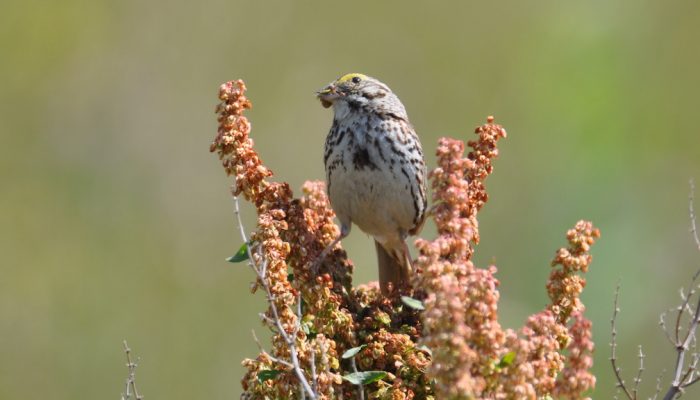 Originally purchased by the Forest Preserve District of Cook County (FPDCC) in the 1960s, Orland Grassland is a 960-acre land and water reserve located in southwestern Cook County. Historically the area was wetter grasslands ranging from sedge marshes to wet-prairie habitat but had succumbed to draining and cultivation by the 1900s.
Originally purchased by the Forest Preserve District of Cook County (FPDCC) in the 1960s, Orland Grassland is a 960-acre land and water reserve located in southwestern Cook County. Historically the area was wetter grasslands ranging from sedge marshes to wet-prairie habitat but had succumbed to draining and cultivation by the 1900s.
The Forest Preserves planted trees along the perimeter leaving an interior tract of grassland habitat used as agricultural lease land for haying.
Intensive restoration efforts by the FPDCC have resulted in the conversion of 750 acres back to open prairie habitat since 2002, with the remaining 210 acres managed as wetlands and woodlands.
Orland Grassland currently boasts a high diversity of bird species and serves as important breeding habitat for Bobolinks, Dickcissels, and Henslow’s Sparrows.
In 2013, the Illinois State Toll Highway Authority (ISTHA) partnered with the FPDCC to restore a 162-acre former farm adjacent to Orland Grassland as mitigation for the Jane Addams Memorial Tollway (I-90) rebuilding and widening project.
Tollway funded restoration work at Orland Grassland South includes native planting and seeding, control of invasive plant species, removal of drain tiles, and restoration of a section of a tributary to Marley Creek (FPDCC, 2013).
We began surveying at the site in 2017 to document the aquatic macroinvertebrate, bat, bird, fish, amphibian, reptile, and mollusk species that currently use the site in its early restoration phases. Overall, our results suggest Orland Grasslands South already provides habitat for sensitive bat and bird species, and with some management effort, it could benefit aquatic species.
In 2020, we conducted bumble bee surveys at Orland Grasslands. We did not encounter the Rusty Patched Bumble Bee, but did detect 8 species across the site, including the American Bumble Bee, an SGCN in the established prairie.
In 2021, we surveyed for bats, birds, dragonflies, butterflies, amphibians, and reptiles:
- Amphibians
- 4 species
- Reptiles
- 6 species
- SGCN Smooth Greensnake at the older portion of Orland Grassland.
- Bats
- we detected Big Brown, Eastern Red, Hoary, Silver-haired, Little Brown, Tricolored, and Evening Bats at the Orland Grassland sites
- similar species composition between the Orland reference and restoration sites.
- Birds
- 51 species of bird at the Orland Grasslands site and
- 48 species at the Orland Grassland South (OGS) restoration site.
- State listed species: King Rails, Black-crowned Night Heron, and Common Terns.
- SGCNs: Dickcissels, Eastern Meadowlarks, Henslow’s Sparrows, Willow Flycatchers, Marsh Wrens, and a Wilson’s Snipe at OGS
- OGS has a much higher density of wetland birds.
- Insects
- The species composition of dragonflies was similar at both sites,
- 13 species of dragonfly at OGS compared to 11 species at the older portion.
- Butterfly species composition was less similar
- OGS had 17 species of butterfly compared to 27 species at the older site.
- Monarchs were present at both sites
- OGS we captured 2 individual Silphium Borers and 2 Blazing Star Borers; both are species SGCNs.
Baker, S.J., E.E. Bilger, S.A. Douglass, T.C. Hohoff, A.A. Rahlin, J.P. Ross, J.L. Sherwood, A.J. Stites, M.L. Niemiller, and M.J. Dreslik. 2018. Organismal monitoring at Orland Grassland South Addition Wetland Mitigation Site. Prepared for Illinois State Toll Highway Authority. Illinois Natural History Survey Technical Report. 2018 (07):1–20.
Rahlin, Anastasia A., Tara C. Hohoff, Janet L. Jarvis, Seth M. LaGrange, Jennifer M. Mui, Valerie A. Sivicek, Jeremy S. Tiemann, and Michael J. Dreslik. 2022. 2021 mitigation site monitoring for Orland Grassland South and Pine Dunes Forest Preserves. Illinois Natural History Survey Technical Report 2022(1)1–48.



















